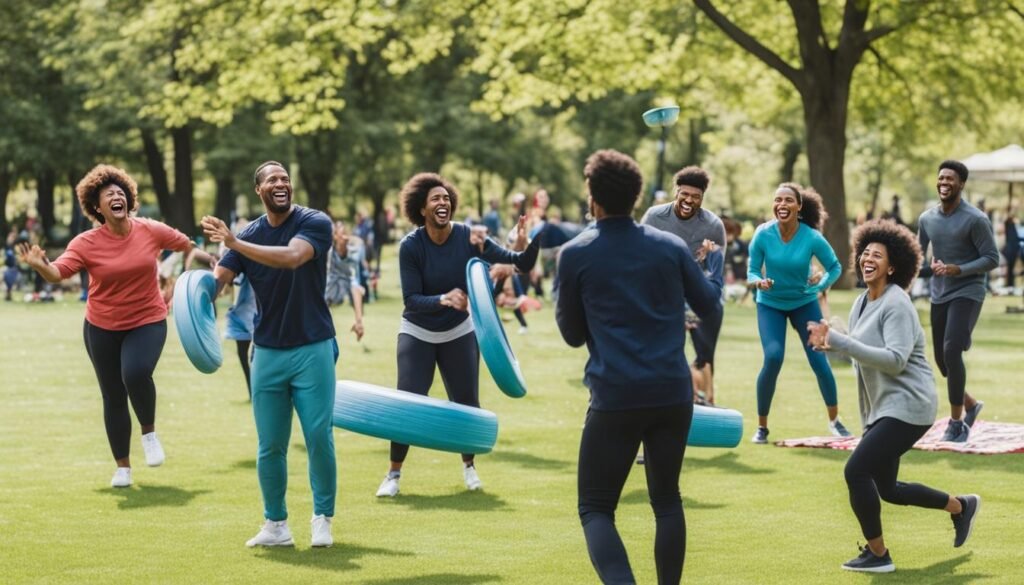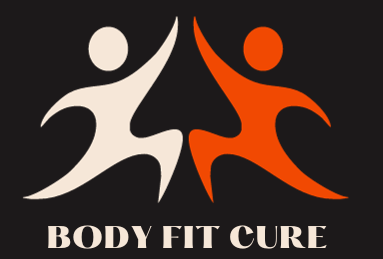Exercise has long been known for its physical benefits, such as weight loss and muscle gain. However, it also offers a plethora of surprising benefits that contribute to overall well-being. From boosting mental health and emotional well-being to improving sleep quality and enhancing social connections, exercise has the power to transform our lives for the better. Join us as we explore these 10 surprising benefits of exercise and discover how it can elevate your well-being.
Key Takeaways:
- Exercise has numerous surprising benefits that go beyond physical fitness.
- Regular physical activity can improve mental health, emotional well-being, and sleep quality.
- Exercise can strengthen social connections and enhance relationships.
- It plays a vital role in weight management and bone health.
- Exercise boosts brain function, productivity, and creativity.
Boosts Mental Health and Emotional Well-being
Exercise has a profound impact on mental health and emotional well-being, offering a wide range of benefits that contribute to overall happiness and positivity. Regular physical activity has been shown to stimulate the release of endorphins, which are natural hormones that improve mood and reduce stress. These feel-good chemicals create a sense of euphoria and happiness, elevating one’s emotional state.
Endorphins also act as natural painkillers, promoting a sense of relaxation and well-being. By engaging in exercise, individuals can alleviate symptoms of anxiety and depression, and manage their overall mental health more effectively.
Moreover, exercise serves as a powerful stress reliever technique. Physical activity helps to reduce the levels of stress hormones such as cortisol, while simultaneously increasing the production of endorphins. This combination allows exercise to reduce tension, improve focus, and enhance emotional resilience. By incorporating exercise into their routine, individuals can effectively manage and alleviate stress, leading to heightened emotional well-being.
Beyond its immediate effects, exercise also provides long-term cognitive benefits. Research suggests that regular physical activity enhances memory and promotes better cognitive function. It increases blood flow to the brain and stimulates the growth of new brain cells, contributing to improved memory retention and recall. Exercise also enhances focus, concentration, and mental clarity, thereby optimizing cognitive performance.
The Role of Endorphins in Mood Improvement
Endorphins play a crucial role in improving mood and overall emotional well-being. These natural chemicals act as neurotransmitters in the brain, binding to specific receptors and reducing the perception of pain. Endorphins are responsible for creating feelings of pleasure and happiness, helping to combat feelings of stress, anxiety, and depression. By engaging in regular exercise, individuals can increase the release of endorphins, naturally boosting mood and promoting emotional well-being.
Exercise as a Stress Reliever Technique
Exercise is a powerful stress reliever technique that helps manage and reduce stress levels. Physical activity stimulates the production of endorphins while reducing the release of stress hormones such as cortisol. This dual impact allows exercise to counter the physiological effects of stress, promote relaxation, and improve overall well-being. Engaging in regular exercise can provide a healthy outlet for stress and help individuals cope with the challenges of daily life more effectively.
Cognitive Benefits and Enhanced Memory
Exercise offers cognitive benefits that extend beyond physical fitness. Regular physical activity enhances memory and improves cognitive function. Through increased blood flow and the growth of new brain cells, exercise supports the brain’s ability to retain and recall information. It also enhances focus, concentration, and mental clarity, enabling individuals to perform at their cognitive best. By incorporating exercise into their routine, individuals can experience enhanced memory and cognitive abilities.
The Surprising Anti-Aging Effects of Regular Workouts
Regular exercise can have surprising anti-aging effects on the body. One of the ways exercise contributes to anti-aging is by preserving telomere length, which is associated with cellular aging. Telomeres are the protective caps at the ends of chromosomes that shorten as cells divide. Shorter telomeres are linked to aging and age-related diseases.
How Exercise Preserves Telomere Length
Exercise has been shown to slow down telomere shortening, helping to maintain their length and overall cellular health. Studies have found that individuals who engage in regular physical activity have longer telomeres compared to sedentary individuals of the same age. This preservation of telomeres through exercise can potentially slow down the biological aging process.
Impact on Skin Health and Appearance
Exercise also has a positive impact on skin health and appearance. When we exercise, blood flow increases, delivering more oxygen and nutrients to the skin cells. This improved circulation helps nourish the skin and promotes a healthy, vibrant complexion. Additionally, exercise stimulates the production of collagen, a protein that helps maintain the elasticity and firmness of the skin. This can result in a more youthful and radiant appearance.
Effects of Exercise on Skin Health and Appearance
| Effects of Exercise | Benefits for Skin Health and Appearance |
|---|---|
| Increased blood flow | Delivers more oxygen and nutrients to skin cells |
| Stimulates collagen production | Improves skin elasticity and firmness |
| Reduced stress | May decrease the risk of stress-related skin issues like acne or eczema |
| Improved sleep quality | Enhances skin’s natural regenerative processes during sleep |
Exercise not only benefits our physical and mental well-being but also has remarkable anti-aging effects on our body and skin. By preserving telomere length and promoting skin health and appearance, regular workouts offer a natural and holistic approach to maintaining a youthful and vibrant look.
Sleep Quality Enhancement through Physical Activity
Exercise plays a vital role in enhancing sleep quality. Regular physical activity helps regulate sleep patterns, reduces insomnia symptoms, and promotes a deeper, more restful sleep. It can also alleviate sleep disorders such as sleep apnea and restless leg syndrome.
Physical activity, such as aerobic exercises, has been shown to improve sleep efficiency and increase total sleep time. According to a study published in the Journal of Clinical Sleep Medicine, engaging in moderate-intensity exercise for at least 150 minutes per week resulted in a significant improvement in sleep quality.
Exercise helps in the production of adenosine, a chemical that promotes sleepiness. By increasing adenosine levels, physical activity can help individuals fall asleep faster and experience less nighttime wakefulness.
A study published in the Journal of Sleep Research found that individuals who engaged in regular physical activity experienced a reduction in the time it took them to fall asleep, as well as an increase in total sleep time. These improvements in sleep quality were especially significant for individuals with insomnia.
Additionally, exercise can regulate the circadian rhythm, the internal body clock that controls sleep-wake cycles. Regular physical activity helps synchronize the circadian rhythm, making it easier for individuals to fall asleep at a consistent time each night and wake up feeling refreshed.
All in all, exercise offers an effective and natural way to enhance sleep quality. By incorporating regular physical activity into your routine, you can enjoy a more restful and rejuvenating sleep, leading to improved overall well-being.
10 Surprising Benefits of Exercise: Improving Social Connections

Exercise is not only beneficial for physical health, but it also has a profound impact on our social connections. Engaging in physical activities can foster relationships and create a sense of community among individuals. Whether it’s through participating in group fitness classes or joining sports teams, exercise provides ample opportunities to meet like-minded individuals and develop meaningful friendships.
Fostering Relationships through Group Fitness
Group fitness classes offer a dynamic environment where individuals gather to exercise together, share their fitness journey, and support one another. Working out in a group setting creates a sense of camaraderie and accountability. The shared experience of challenging workouts and achieving fitness goals together builds a strong bond among participants.
“Group fitness classes have not only improved my physical health but have also allowed me to make new friends who share the same passion for fitness. We motivate and inspire each other to push our limits and achieve our goals.”
– Sarah, Fitness Enthusiast
The Community Aspect of Shared Physical Activities
Engaging in physical activities that involve the community, such as charity runs or team sports, can strengthen existing relationships and create new connections. These shared experiences promote a sense of belonging and unity, as individuals come together to support a common cause or challenge themselves as a team.
Exercise can also be a great way to bond with family and friends. Whether it’s going for a hike, playing a game of tennis, or taking a dance class together, shared physical activities offer an opportunity to spend quality time with loved ones while improving fitness and overall well-being.
Overall, exercise not only benefits our physical health but also enhances our social connections. By participating in group fitness classes and engaging in shared physical activities, we can meet new people, develop friendships, and foster a sense of community. So, grab a friend or join a local fitness group, and experience the social benefits of exercise while improving your health!
Unexpected Weight Management Partner: Exercise
Exercise is often associated with weight loss, but its role in weight management goes beyond that. Regular physical activity offers a comprehensive approach to maintaining a healthy weight and achieving optimal body composition.
When it comes to weight loss, exercise is a powerful tool. It helps burn calories, promoting a calorie deficit that leads to weight loss. Additionally, exercise builds lean muscle mass, which increases metabolism and helps burn more calories even at rest.
However, exercise is equally important for weight maintenance. It helps prevent weight regain by increasing energy expenditure and preserving muscle mass. Regular exercise also plays a role in weight control by reducing appetite and increasing feelings of fullness, which can help prevent overeating and cravings.
To effectively manage weight, a combination of aerobic exercise and strength training is recommended. Aerobic exercise, such as running, swimming, or cycling, burns calories and improves cardiovascular health. Strength training, on the other hand, builds lean muscle mass and boosts metabolism.
Exercise not only contributes to weight management but also offers numerous other health benefits. It improves overall fitness, reduces the risk of chronic diseases, enhances mental well-being, and increases energy levels. Incorporating regular exercise into your lifestyle is a sustainable approach to achieving and maintaining a healthy weight.
Make exercise a part of your daily routine and enjoy the transformative effects it has on your weight and overall well-being.
Exercise and Its Role in Bone Health
Exercise plays a crucial role in maintaining and improving bone health. It is essential for people of all ages to engage in regular physical activity to support strong and healthy bones. In particular, two types of exercises are beneficial for bone health: strength training and high-impact workouts.
Preventing Osteoporosis with Strength Training
Strength training exercises are particularly effective in preventing osteoporosis. These exercises involve using resistance, such as weights or resistance bands, to strengthen muscles and put stress on the bones. This stress stimulates the bones to become stronger and denser over time. Some examples of strength training exercises include weightlifting, squats, and push-ups.
How High-Impact Workouts Benefit Bone Density
High-impact workouts, such as jumping or running, are also beneficial for bone health. These exercises involve repetitive movements where both feet leave the ground, creating an impact. The impact helps stimulate bone growth and increases bone density. High-impact exercises are especially important for maintaining strong bones as we age, as they can help reduce the risk of fractures. However, it’s important to note that individuals with certain conditions, such as joint problems or osteoporosis, should consult with a healthcare professional before engaging in high-impact exercises.
Regular exercise not only improves bone density but also enhances flexibility and balance. This is crucial for preventing falls and reducing the likelihood of bone fractures, especially in older adults. By incorporating strength training exercises and high-impact workouts into your exercise routine, you can promote optimal bone health and reduce the risk of osteoporosis.
Sharper Brain Function and Productivity
Exercise as a Cognitive Booster
Exercise has been shown to enhance brain function and improve cognitive abilities. When we engage in physical activity, it promotes the growth of new brain cells, also known as neurogenesis. This process contributes to improved memory, learning, and overall cognitive function. Regular exercise has also been linked to a reduced risk of cognitive decline and age-related cognitive diseases such as Alzheimer’s.
Furthermore, exercise increases blood flow to the brain, delivering essential nutrients and oxygen that support optimal brain function. It stimulates the release of chemicals called growth factors, which promote the growth, repair, and protection of brain cells. These factors, including brain-derived neurotrophic factor (BDNF), can enhance synaptic plasticity, leading to improved learning, focus, and attention.
Exercise has also been recognized as a powerful tool for enhancing productivity. By incorporating physical activity into our routines, we can experience increased focus, attention, and problem-solving skills. Exercise stimulates the release of neurotransmitters like dopamine, serotonin, and norepinephrine, which are known to regulate mood and improve cognitive function.
The Connection Between Physical Exercise and Work Efficiency
Studies have revealed a strong link between exercise and work efficiency. Engaging in regular physical activity can positively impact various aspects of work performance. Exercise helps to reduce stress and improve overall well-being, resulting in fewer distractions and increased concentration on tasks. It also enhances energy levels, enabling individuals to tackle tasks more efficiently and stay productive throughout the day.
Furthermore, exercise has been shown to enhance creativity and problem-solving abilities, which are highly valuable skills in the workplace. By incorporating regular exercise into our routines, we can experience a boost in divergent thinking, increased cognitive flexibility, and improved decision-making capabilities.
Incorporating exercise into our daily lives not only contributes to better brain function but also enhances overall productivity and work efficiency. By prioritizing physical activity, we can optimize our mental performance and achieve greater success in our personal and professional lives.
Internal Health Benefits: Exercise and Disease Prevention

Exercise offers numerous internal health benefits and plays a crucial role in disease prevention. Regular physical activity can reduce the risk of chronic conditions such as heart disease, diabetes, and certain types of cancer. It also helps manage blood pressure, cholesterol levels, and blood sugar levels. Exercise strengthens the immune system, improves lung function, and enhances overall cardiovascular health.
To illustrate the importance of exercise for disease prevention, consider the following:
“Physical inactivity is a leading cause of most chronic diseases, and regular exercise can significantly reduce the risk of developing these conditions.”
– American Heart Association
The prevalence of chronic diseases such as heart disease and diabetes has reached alarming levels, with sedentary lifestyles and unhealthy habits contributing to the growing burden of these conditions. However, engaging in regular exercise can help mitigate these risks and promote better internal health.
Research has consistently shown that exercise is an effective preventive measure against chronic diseases. It helps maintain a healthy weight, which is crucial for reducing the risk of conditions such as heart disease and diabetes. Physical activity also improves insulin sensitivity, reducing the likelihood of insulin resistance and the development of type 2 diabetes.
Furthermore, exercise plays a vital role in managing blood pressure and cholesterol levels, both of which are closely linked to heart health. Regular physical activity helps lower blood pressure, improve blood circulation, and reduce the risk of arterial plaque buildup. It also raises levels of high-density lipoprotein (HDL) cholesterol, the “good” cholesterol that helps remove low-density lipoprotein (LDL) cholesterol, commonly known as the “bad” cholesterol, from the bloodstream.
In addition to its impact on specific chronic diseases, exercise strengthens the immune system, making individuals less susceptible to infections and illnesses. Physical activity increases the production of antibodies and stimulates the circulation of immune cells, enhancing the body’s ability to fight off pathogens.
Beyond these specific benefits, exercise has a positive impact on overall cardiovascular health. Regular physical activity improves heart function, increases cardiac output, and enhances oxygen delivery to the body’s tissues. These effects contribute to a lower risk of cardiovascular diseases, including heart attacks and strokes.
In summary, exercise is an indispensable tool for disease prevention and internal health. Regular physical activity reduces the risk of chronic conditions, supports heart health, manages blood pressure and cholesterol levels, strengthens the immune system, and enhances overall cardiovascular function.
Table:
| Chronic Condition | Risk Reduction through Exercise |
|---|---|
| Heart Disease | Regular physical activity lowers blood pressure, improves cholesterol levels, and strengthens the heart muscle. |
| Diabetes | Exercise enhances insulin sensitivity, helps maintain a healthy weight, and reduces the risk of developing type 2 diabetes. |
| Cancer | Engaging in physical activity can lower the risk of certain types of cancer, including breast, colon, and lung cancer. |
By incorporating exercise into our daily lives, we can take proactive steps towards preventing chronic diseases and promoting optimal internal health.
Self-Esteem and Confidence: Surprising Gains from Exercise
Exercise has surprising benefits for self-esteem and confidence. Regular physical activity promotes body positivity, improves body image, and enhances self-perception. Achieving fitness goals, such as increasing strength or endurance, can boost self-confidence and self-worth. Exercise also releases endorphins that contribute to a positive self-image and improved mental well-being.
Creative Thinking and Exercise: An Unexpected Link
Physical exercise has an unexpected link to creative thinking. Engaging in aerobic exercises, such as jogging or cycling, can stimulate the production of new brain cells and enhance cognitive flexibility, leading to improved creativity. Walking workouts have also been found to boost ideation processes, making them an excellent choice for brainstorming and problem-solving.
Exercise and creativity are closely intertwined, as physical activity promotes the growth of new brain cells and enhances cognitive flexibility. Engaging in aerobic exercises, such as jogging or cycling, can stimulate the production of new neurons in the brain, a process known as neurogenesis. The increased connectivity between brain regions allows for enhanced communication and creative thinking, leading to innovative ideas and solutions.
“Creativity is intelligence having fun.” – Albert Einstein
Walking workouts are particularly effective for boosting the ideation process. Taking a brisk walk outdoors can have a positive impact on creative thinking and problem-solving abilities. A change in environment, fresh air, and the rhythm of walking can stimulate the brain, promoting the flow of ideas and facilitating the generation of creative insights. Walking workouts provide an opportunity for uninterrupted contemplation, allowing the mind to wander and explore new possibilities.
Next time you find yourself in need of a creative boost, lace up your shoes and go for a walk or engage in an aerobic exercise. You may discover that physical activity not only improves your physical health but also ignites your imagination and enhances your creative thinking.
Conclusion
Exercise has the power to transform your life in ways that go far beyond physical fitness. Throughout this article, we have explored 10 surprising benefits of exercise that positively impact various aspects of well-being. From improving mental health and emotional well-being to enhancing sleep quality and fostering social connections, regular physical activity can truly revolutionize your life.
The transformative power of exercise is evident in its ability to promote anti-aging effects, such as preserving telomere length and improving skin health. It also plays a crucial role in weight management, bone health, and brain function. Furthermore, exercise offers internal health benefits and can help prevent chronic diseases, while also boosting self-esteem, confidence, and creativity.
So, what are you waiting for? It’s never too late to embark on a fitness journey and experience the incredible benefits of exercise. Start by finding activities you enjoy and gradually incorporate physical activity into your daily routine. Whether it’s going for a walk, joining a group fitness class, or lifting weights at the gym, embrace the power of exercise and unlock a healthier, happier version of yourself.
FAQ
What are the surprising benefits of exercise?
Exercise offers a range of surprising benefits beyond weight loss and muscle gain. It boosts mental health and emotional well-being, improves sleep quality, enhances social connections, provides anti-aging effects, aids in weight management, promotes bone health, sharpens brain function and productivity, prevents diseases, boosts self-esteem and confidence, fuels creativity, and more.
How does exercise boost mental health and emotional well-being?
Exercise stimulates the release of endorphins, which are feel-good hormones that improve mood and reduce stress. It also acts as a stress reliever technique, helps manage anxiety and depression, and enhances cognitive function, including memory and focus.
What are the anti-aging effects of exercise?
Regular exercise preserves telomere length, which is associated with cellular aging. It also improves skin health and appearance by promoting better circulation and oxygenation, resulting in a youthful glow.
How does exercise enhance sleep quality?
Exercise helps regulate sleep patterns, reduces insomnia symptoms, and promotes a deeper, more restful sleep. It can also alleviate sleep disorders such as sleep apnea and restless leg syndrome.
How does exercise improve social connections?
Participating in group fitness classes or activities provides opportunities to meet like-minded individuals, develop friendships, and build a sense of community. The shared experience of physical activities can strengthen existing relationships and create new connections.
Is exercise effective for weight management?
Yes, exercise plays a crucial role in weight management. It helps burn calories, build lean muscle mass, boost metabolism, reduce appetite, and increase feelings of fullness.
How does exercise contribute to bone health?
Strength training exercises increase bone density and strengthen bones, preventing osteoporosis. High-impact workouts stimulate bone growth and reduce the risk of fractures. Regular exercise also improves flexibility and balance.
How does exercise impact brain function and productivity?
Exercise promotes the growth of new brain cells, enhances cognitive abilities, improves memory and learning, increases focus, attention, and problem-solving skills. It is even linked to improved work efficiency and performance.
What are the internal health benefits of exercise?
Exercise reduces the risk of chronic conditions such as heart disease, diabetes, and certain types of cancer. It helps manage blood pressure, cholesterol levels, and blood sugar levels. Exercise strengthens the immune system, improves lung function, and enhances overall cardiovascular health.
How does exercise boost self-esteem and confidence?
Regular physical activity promotes body positivity, improves body image, and enhances self-perception. Achieving fitness goals can boost self-confidence and self-worth. Exercise also releases endorphins that contribute to a positive self-image and improved mental well-being.
How does exercise relate to creativity?
Engaging in aerobic exercises stimulates the production of new brain cells and enhances cognitive flexibility, leading to improved creativity. Walking workouts are also known to boost ideation processes, making them excellent for brainstorming and problem-solving.




